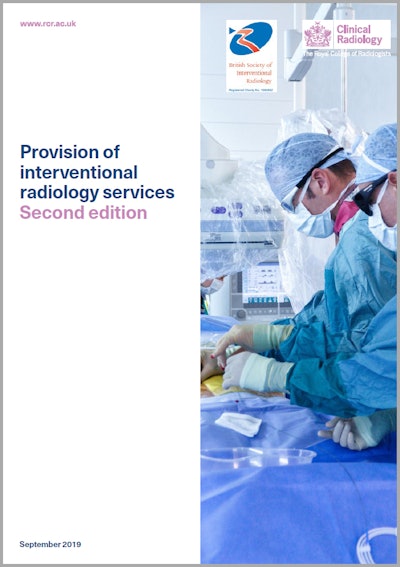
How many qualified interventional radiologists does a hospital really need on its payroll to deliver a comprehensive service for patients? In a new 22-page document, the U.K. Royal College of Radiologists (RCR) has provided some much-needed answers.
"The provision of interventional radiology services ... remains variable with many hospitals having limited or, in some instances, no direct access. This is particularly true out of hours," noted the authors of "Provision of interventional radiology services: Second edition."
"The number of interventional radiologists within a unit is clearly a key factor in determining the approach to developing a safe and sustainable rota," they added.
In the document, they have the following workforce recommendations:
- Services with fewer than four interventional radiologists should liaise with neighboring units to develop a model of care that will permit robust interventional radiology rotas.
- Services with four to six interventional radiologists may be able to provide an on-call rota, depending on the intensity of activity. Most services in this range should consider networking with neighboring units to ensure a more robust long-term service.
- Services consisting of six or more interventional radiologists will usually be able to provide a robust 24/7 service that is compliant with the European Working Time Directive (EWTD) or equivalent. For populations greater than 1 million, a 1:8 rota may be more sustainable.
The report demonstrates the range of services offered by interventional radiologists and sets out the core requirements for the provision of an interventional radiology service, both in district general hospitals and tertiary or teaching hospitals. It aims to advise on how services may be set up collaboratively within regions to offer the highest quality of care to patients.
There is a significant shortage of interventional radiologists in the U.K., with almost half (45%) of English hospitals not currently able to provide either local or networked access to interventional radiology, according to the authors. Data from the 2018 RCR workforce census suggest an approximate need for 379 consultants in interventional radiology to achieve a rota of 1:6 (see table).
| Workforce required for interventional radiology (IR) 24/7 cover as a 1:6 rota | ||||||
| Region | No. of trusts/health boards | Consultant radiologists with primary interest in IR (WTE) | Consultant radiologists with secondary interest in IR (WTE) | Total IR consultants (WTE) | Additional IRs required to provide 1:6 on-call rota in each trust/health board* | IR shortfall |
| England | 148 | 511 | 63 | 574 | 320 | 36% |
| Northern Ireland | 5 | 16 | 4 | 19 | 17 | 47% |
| Scotland | 12 | 39 | 4 | 43 | 29 | 40% |
| Wales | 7 | 19 | 5 | 24 | 13 | 35% |
| U.K. total | 172 | 585 | 76 | 661 | 379 | 36% |
WTE = working time equivalent.
"There remain a large number of unfilled interventional radiology consultant posts in the U.K. due to a shortage of suitably trained candidates and early retirements. ... Expansion of the number of trainees in interventional radiology is, therefore, urgently required as a continued shortfall will be damaging to both elective and emergency patient care," they stated.
A skilled and robust workforce is also essential for the delivery of a 24/7 mechanical thrombectomy service for large-vessel occlusion stroke, which is a highly effective but very time-dependent treatment, they added.
Priority for acute hospitals
Access to 24/7 interventional radiology cover should be a priority for all acute hospitals, and units that undertake acute medical and surgical care must have access to interventional radiology services, particularly hemorrhage control and drainage of sepsis (e.g., nephrostomy) either onsite or by formal arrangement to transfer the patient to a site where the service is available, the authors continued.

"Transfer procedures and policies must be developed to detail transfer arrangements between hospital trusts for emergency interventional radiology cases. Specific consideration should be given to the transfer of unstable bleeding patients as interventional radiology is lifesaving in this situation," they wrote. "Transfer direct to an available staffed unit with appropriate levels of support from critical care and acute services, not affected by 100% bed occupancy risk, under a nominated defined clinician located near to the interventional radiology department should be considered."
Transfer should occur within 30 minutes of the clinical decision for treatment, and reconfigurations to individual services should ensure that a continuity of access to interventional radiology services is maintained in a safe manner for patients. This is paramount for emergency care, which includes acute admissions as well as inpatient emergencies such as post-op hemorrhage, sepsis, and gastrointestinal bleeding, they noted.
"The increasing clinical role played by interventional radiology staff requires changes in the way that these highly specialized doctors are trained and this needs to be reflected in the way that job plans are developed," the authors wrote.
"Interventional radiology image-guided surgery requires the appropriate clinical time for ward work, outpatient clinics, and access to day-case beds in line with other surgical specialties," they added. "This is also the case for the interventional nurses and radiographers whose skills are vital to ensuring the safe delivery of care for patients undergoing interventional procedures."
You can download a copy of the document free of charge from the RCR website.



















